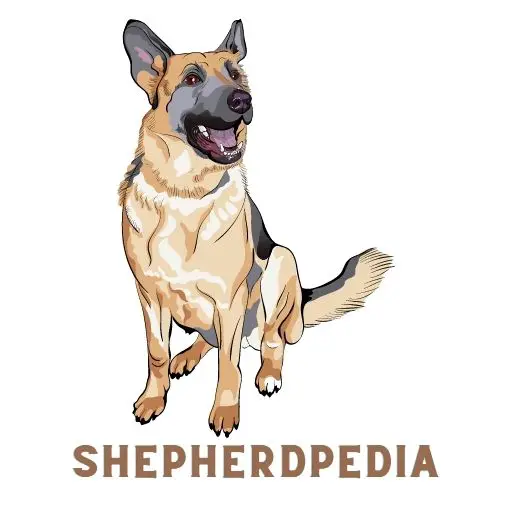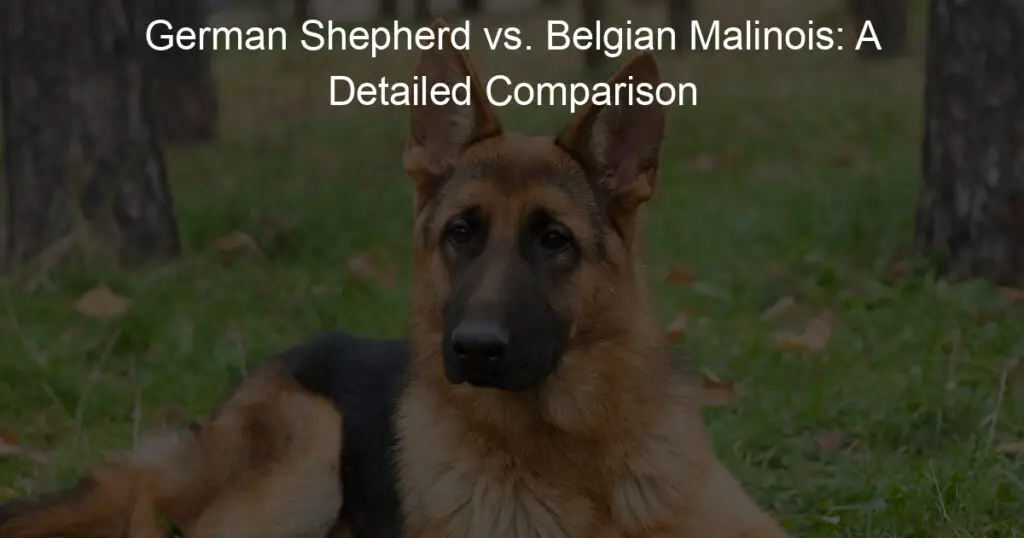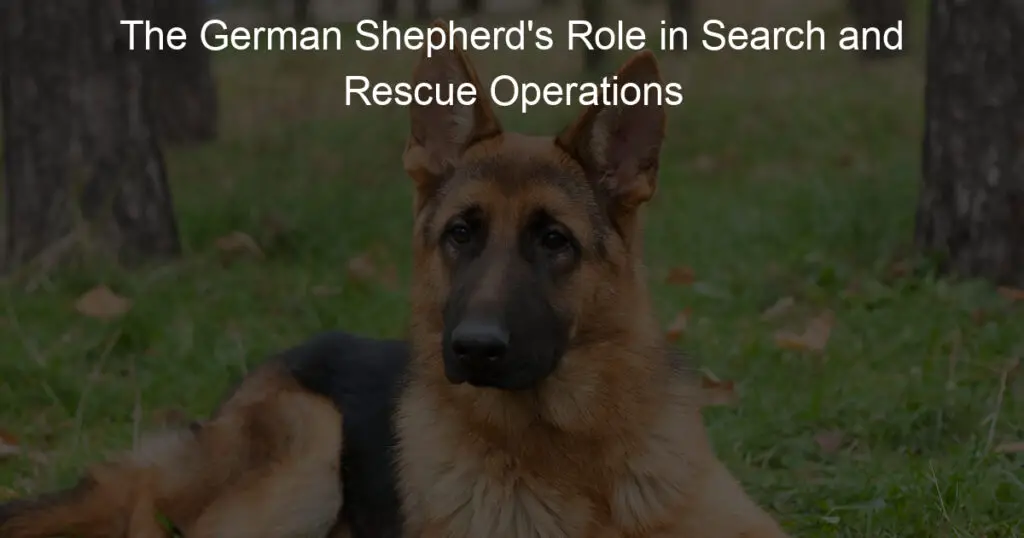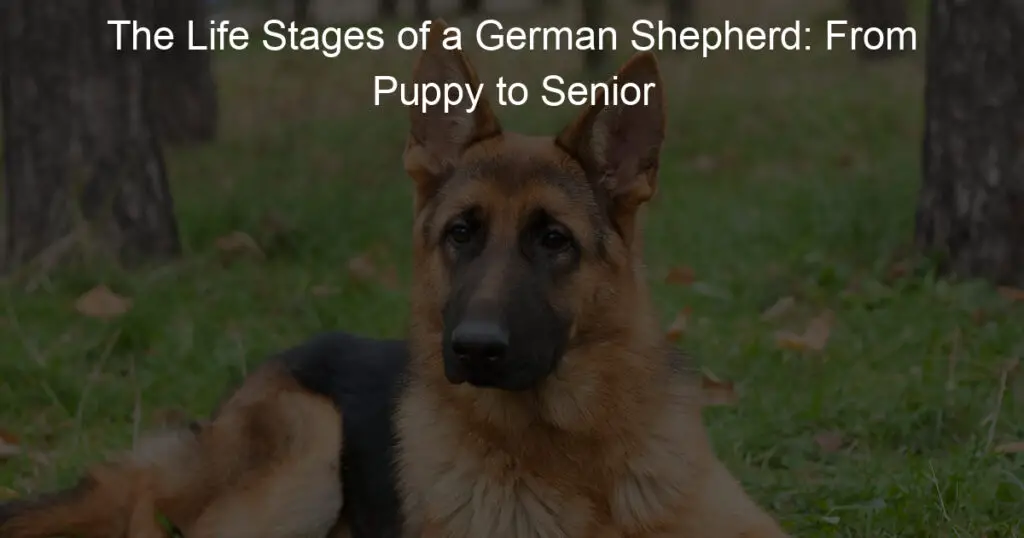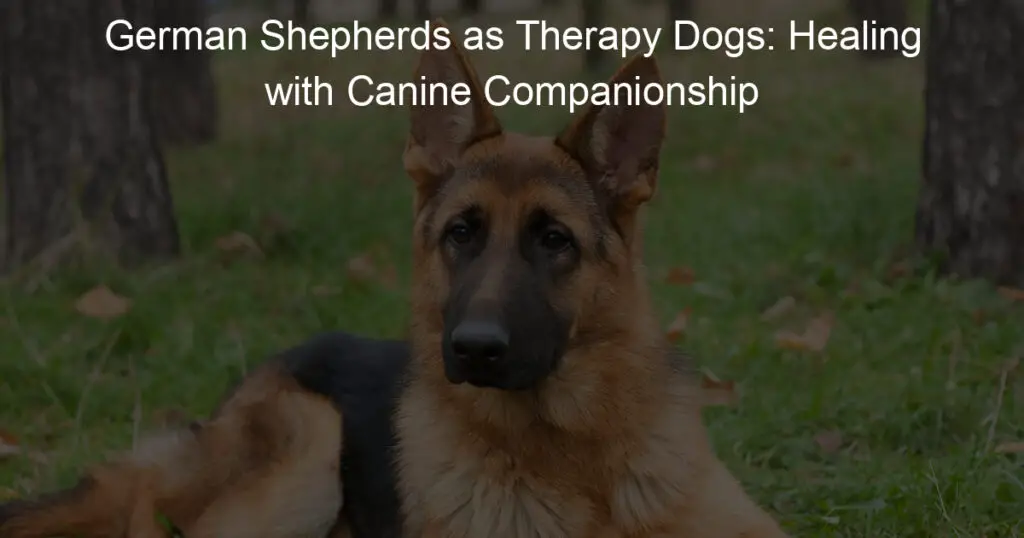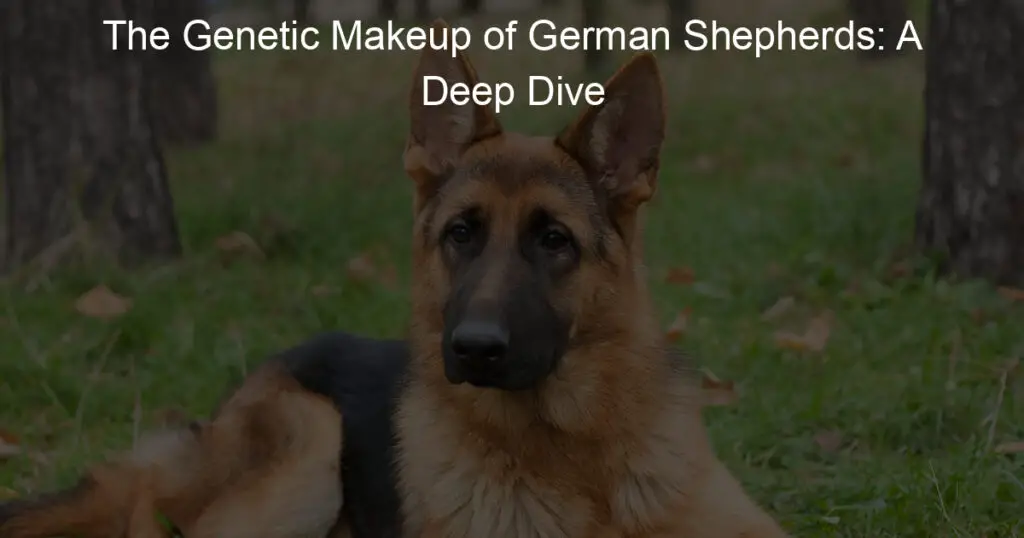This blog post provides a comprehensive comparison between two popular working dog breeds: the German Shepherd and the Belgian Malinois. While both breeds share a common lineage and were developed for similar purposes, they have distinct characteristics and traits that set them apart. In this post, we will delve into their history, physical characteristics, temperament, training needs, health issues and suitability as family pets.
Introduction to the German Shepherd and Belgian Malinois
The German Shepherd and Belgian Malinois are two popular dog breeds known for their intelligence, loyalty, and versatility. Both breeds have a rich history and are widely recognized for their working abilities. German Shepherds originated in Germany in the late 19th century, while Belgian Malinois originated in Belgium. These breeds were initially bred for different purposes, but today they are commonly used in various roles such as police and military work, search and rescue operations, and as loyal family pets.
German Shepherds are renowned for their protective nature, making them excellent guard dogs. They are known for their strong work ethic, intelligence, and trainability. Belgian Malinois, on the other hand, are highly energetic and agile. They are often preferred for their speed and endurance, making them ideal for tasks that require quick reflexes and physical agility.
Despite their differences in appearance and temperament, both breeds share certain characteristics. They are both highly trainable and have a strong desire to please their owners. Additionally, both breeds are known for their loyalty and devotion to their families. However, it is important to note that these breeds require experienced owners who can provide them with proper training, socialization, and mental stimulation.
The Origins: Where did the German Shepherd and Belgian Malinois come from?
The German Shepherd and Belgian Malinois both have interesting and distinct origins. The German Shepherd, as the name suggests, originated in Germany in the late 19th century. Captain Max von Stephanitz is credited with the development of the breed. He aimed to create a versatile working dog capable of herding livestock with intelligence and obedience. The German Shepherd's ancestry can be traced back to various herding dogs from the German region. Over time, the breed gained popularity and was recognized for its exceptional working abilities.
In contrast, the Belgian Malinois originated in Belgium and is named after the city of Malines. The breed was developed in the late 19th century by Belgian shepherd breeders. Initially, the Belgian Malinois was one of several varieties of Belgian shepherd dogs. However, due to its exceptional traits and working abilities, it was separated as its own distinct breed. The Belgian Malinois was primarily bred for herding and guarding livestock, but its intelligence and versatility led to its use in various working roles such as police and military work.
Physical Comparison: How do they look?
When comparing the physical appearance of the German Shepherd and the Belgian Malinois, there are several key differences to consider.
- 1. Size and Build:
The German Shepherd is a larger breed, typically weighing between 50-90 pounds and standing 22-26 inches tall at the shoulder. They have a strong and muscular build, with a distinct sloping back. On the other hand, the Belgian Malinois is slightly smaller, weighing between 40-80 pounds and standing 22-26 inches tall. They have a more compact and athletic build, with a level back. - 2. Coat and Colors:
Both breeds have a double coat, but the German Shepherd's coat is typically longer and thicker. Their coat comes in various colors, including black, tan, sable, and solid black. In contrast, the Belgian Malinois has a shorter and denser coat, often described as a "malinois fawn" color with a black mask on their face and black-tipped fur. - 3. Facial Features:
The German Shepherd has a more distinct and recognizable facial structure. They have a strong, noble-looking head with a slightly domed forehead and a long, pointy muzzle. Their ears are large and erect. On the other hand, the Belgian Malinois has a more fox-like appearance with a narrower skull and a slightly shorter muzzle. Their ears are also large and erect, giving them an alert and attentive expression.
"Size does matter" – A look at their sizes
When comparing the sizes of the German Shepherd and the Belgian Malinois, it is important to consider their height, weight, and overall build.
- 1. Height:
The German Shepherd typically stands between 22-26 inches tall at the shoulder, making them a relatively tall breed. In contrast, the Belgian Malinois stands at a similar height range of 22-26 inches, showcasing their compact and agile stature. - 2. Weight:
The German Shepherd is generally heavier than the Belgian Malinois, with an average weight range of 50-90 pounds. Their muscular build contributes to their weight. On the other hand, the Belgian Malinois weighs slightly less, ranging from 40-80 pounds. Despite the difference in weight, both breeds are known for their strength and endurance. - 3. Overall Build:
The German Shepherd has a larger and more robust build compared to the Belgian Malinois. Their body structure is solid and well-muscled, reflecting their role as a versatile working dog. In contrast, the Belgian Malinois has a more compact and leaner build, which emphasizes their athleticism and agility. This difference in build is often attributed to their respective roles and purposes.
Temperament: How do they behave?
The temperament of a dog is a crucial aspect to consider when choosing a breed. Both the German Shepherd and the Belgian Malinois exhibit distinct behavioral traits that make them unique.
One of the key traits of the German Shepherd is their loyalty and protective nature. They are known for their strong bond with their family and are often considered excellent family pets. German Shepherds are generally calm and confident, but they can also be wary of strangers, making them excellent guard dogs. They are intelligent and highly trainable, which allows them to excel in various tasks and roles.
The Belgian Malinois, on the other hand, is known for its high energy levels and intense drive. They are extremely agile and have a strong work ethic. Belgian Malinois are often used as working dogs in roles such as police and military work, as well as in search and rescue operations. They require mental and physical stimulation to prevent boredom and potential behavioral issues. Belgian Malinois are highly alert and responsive, making them quick to react to their surroundings.
While both breeds are generally loyal and protective, the German Shepherd tends to be more reserved and cautious, while the Belgian Malinois is typically more active and driven. It is important to note that both breeds require proper socialization and training from an early age to ensure they grow into well-rounded and balanced dogs.
Training Needs: Which one is easier to train?
When it comes to training, both the German Shepherd and the Belgian Malinois are highly intelligent and trainable breeds. However, there are some differences in their training needs and ease of training.
- 1. Intelligence and Trainability:
Both the German Shepherd and the Belgian Malinois are known for their high intelligence levels. They are quick learners and eager to please their owners. This makes them highly trainable for a variety of tasks and commands. German Shepherds are known for their ability to understand and follow complex instructions, making them suitable for advanced training. On the other hand, Belgian Malinois are highly focused and have a strong work ethic, making them excel in obedience and specialized training. - 2. Energy and Drive:
The energy levels and drive of a dog can significantly impact their trainability. German Shepherds are generally more laid-back compared to the Belgian Malinois, which has a higher energy level and intense drive. While the German Shepherd may be easier to handle and train for first-time dog owners, the Belgian Malinois requires a more experienced and dedicated trainer to channel their energy effectively. They thrive in environments that provide them with plenty of mental and physical stimulation. - 3. Socialization and Obedience:
Proper socialization plays a vital role in the training of both breeds. German Shepherds tend to be more naturally social and may be easier to socialize with people and other animals. They are known to be more tolerant and adaptable in various social situations. On the other hand, Belgian Malinois can be more reserved and cautious, requiring careful socialization to ensure they are comfortable and well-behaved around new people and animals. Obedience training is essential for both breeds to ensure they understand and obey commands consistently.
Health Issues: Are they prone to specific health problems?
Both the German Shepherd and Belgian Malinois are generally healthy breeds, but like all dogs, they can be prone to certain health issues. It's important for potential owners to be aware of these potential health problems and take necessary precautions.
One common health concern for both breeds is hip and elbow dysplasia. This is a genetic condition where the joints do not develop properly, leading to pain, lameness, and arthritis. Regular exercise, a balanced diet, and proper weight management can help reduce the risk of these conditions. Additionally, both breeds may also be prone to certain hereditary eye diseases such as cataracts and progressive retinal atrophy (PRA). Regular eye examinations by a veterinarian can help detect and manage these conditions.
Another health issue that may affect German Shepherds is degenerative myelopathy, a progressive disease that affects the spinal cord and can lead to hind limb weakness and paralysis. Belgian Malinois, on the other hand, may be more prone to developing certain skin allergies and sensitivities. Regular grooming and proper hygiene practices can help prevent skin-related issues in both breeds.
It's also important to note that both breeds are susceptible to bloat, also known as gastric dilatation-volvulus (GDV). This is a life-threatening condition where the stomach twists, leading to a blockage and potential organ damage. Feeding smaller, frequent meals, avoiding exercise immediately after meals, and monitoring their eating habits can help reduce the risk of bloat.
Life Expectancy: How long do they usually live?
The average life expectancy for both German Shepherds and Belgian Malinois ranges from 10 to 14 years. However, it's important to note that individual dogs may vary and factors such as genetics, diet, exercise, and overall healthcare can influence their lifespan.
German Shepherds typically have a slightly shorter lifespan compared to Belgian Malinois. Generally, they live between 10 and 12 years. However, with proper care and a healthy lifestyle, some German Shepherds have been known to live well into their teens.
On the other hand, Belgian Malinois tend to have a slightly longer lifespan, ranging from 12 to 14 years. Again, this can vary based on individual health and care.
It's worth mentioning that both breeds are prone to certain health issues that can affect their longevity. Regular veterinary check-ups, a balanced diet, exercise, and providing a safe and stimulating environment can help maximize their lifespan.
Additionally, responsible breeding practices can also play a role in the overall health and longevity of these breeds. Reputable breeders conduct health screenings on their breeding stock to ensure healthier puppies with a better chance of living longer lives.
Do they make good family pets?
Both German Shepherds and Belgian Malinois can make excellent family pets, but it's important to consider certain factors before bringing either breed into a household.
German Shepherds are known for their loyalty and protective nature, making them great companions and family guardians. They are often gentle and patient with children, forming strong bonds with their family members. However, their protective instincts can sometimes lead to wariness around strangers, so early socialization is crucial to ensure they grow up to be well-rounded and friendly dogs.
Belgian Malinois, on the other hand, are highly intelligent and energetic dogs. They are incredibly loyal to their families and are often described as being eager to please. With proper training and socialization, they can make wonderful family pets. However, their high energy levels and need for mental stimulation mean they require an active lifestyle and plenty of exercise.
Both breeds thrive in homes where they receive plenty of attention, mental stimulation, and physical exercise. They are not well-suited to a sedentary lifestyle or being left alone for long periods.
It's also worth noting that the size and strength of these breeds can be a consideration for families with young children or elderly members. Proper training and supervision are essential to ensure that both the dog and the family members are safe and comfortable.
Adaptability: How well do they adapt to different environments?
Both German Shepherds and Belgian Malinois are known for their adaptability to different environments, although there are some differences to consider.
German Shepherds are known to be versatile and adaptable dogs. They can thrive in various living situations, including apartments as long as they receive sufficient exercise and mental stimulation. However, they do best in homes with a yard where they have space to roam and play. German Shepherds can also adapt well to different climates, but they may struggle in extreme heat or cold without proper precautions.
Belgian Malinois, being highly adaptable by nature, can adjust to different environments with relative ease. They are often used as working dogs in various roles such as police work, search and rescue, and even as therapy dogs. Belgian Malinois are known for their ability to handle different climates, including hot and cold weather conditions. They have a dense double coat that provides insulation and protection from the elements.
It's important to note that both breeds require mental stimulation and physical exercise to prevent boredom and destructive behaviors. They thrive in environments where they receive regular exercise, training, and social interaction.
When considering the adaptability of these breeds, it is essential to evaluate your own lifestyle and living situation. If you live in a small apartment or have limited access to outdoor space, a German Shepherd may still adapt, but a Belgian Malinois may be more suitable due to their high energy levels and need for physical activity. Conversely, if you have ample space and an active lifestyle, both breeds can adapt well.
Exercise Needs: How much exercise do they need?
Both German Shepherds and Belgian Malinois are highly active and energetic breeds that require a significant amount of exercise to maintain their physical and mental well-being.
German Shepherds typically require at least 1-2 hours of exercise per day to stay happy and healthy. This can include activities such as brisk walks, jogging, playing fetch, and engaging in interactive games. They enjoy activities that challenge their intelligence and problem-solving abilities, such as obedience training and agility exercises. It's important to note that German Shepherds have a strong herding instinct, so providing them with opportunities to engage in activities that simulate this behavior, such as herding balls or participating in herding trials, can be beneficial.
Belgian Malinois, on the other hand, have even higher exercise needs. They are a highly active breed that thrives on intense physical activity and mental stimulation. They require at least 2 hours or more of exercise per day to prevent boredom and behavioral issues. This can include activities such as running, hiking, playing frisbee, and participating in advanced obedience training or sports like agility or flyball. Due to their high energy levels, Belgian Malinois are often used as working dogs in demanding roles that require stamina and endurance.
It's important to emphasize that regular exercise for both breeds is not just about physical activity but also mental stimulation. These intelligent breeds need activities that challenge them mentally, such as obedience training, puzzle toys, and interactive play sessions.
Grooming: How much grooming do they require?
German Shepherds and Belgian Malinois have different grooming requirements. Let's take a closer look at how much grooming each breed needs.
- Coat Type:
German Shepherds have a dense double coat that sheds year-round. They require regular brushing to remove loose hair and prevent matting. During shedding seasons, which typically occur twice a year, they will "blow" their coat and require more frequent brushing to manage the increased shedding. It's also important to note that German Shepherds should not be shaved as their coat helps regulate their body temperature.Belgian Malinois also have a double coat, but their coat is shorter and less dense than that of German Shepherds. They shed moderately throughout the year and may have heavier shedding periods during seasonal changes. Regular brushing is still necessary to remove loose hair and keep their coat healthy.
- Bathing:
Both breeds do not require frequent bathing unless they get particularly dirty or smelly. Bathing them too often can strip their coat of natural oils and cause skin dryness. It's recommended to bathe them every few months or as needed. - Nail Trimming:
Regular nail trimming is essential for both breeds. Long nails can cause discomfort and even affect their gait. Trimming their nails every 4-6 weeks is typically sufficient, but individual dogs may require more frequent trimming if their nails grow quickly. - Ears and Teeth:
Regular ear cleaning is important for both breeds, as they can be prone to ear infections. Gently wiping their ears with a veterinarian-approved ear cleaner and cotton balls can help prevent issues. Additionally, dental hygiene is crucial for their overall health. Daily brushing of their teeth with a dog-specific toothbrush and toothpaste, as well as providing dental chews, can help maintain good oral hygiene.
Food and Diet: What are their dietary needs?
Both German Shepherds and Belgian Malinois have similar dietary needs. They are both medium to large-sized breeds that require a balanced and nutritious diet to support their active lifestyles and maintain optimal health.
A high-quality, commercially prepared dog food that is specifically formulated for large breeds is recommended for both breeds. Look for dog food that lists real meat, such as chicken or beef, as the first ingredient. This ensures they receive the necessary protein for muscle growth and development.
It's important to note that the amount of food they require will depend on factors such as age, weight, activity level, and metabolism. Puppies will require more frequent meals and a diet specifically formulated for their growth and development. Adult dogs typically require two meals per day, spaced out evenly.
Avoid overfeeding as both breeds can be prone to weight gain, which can put stress on their joints and lead to various health issues. Regularly monitoring their weight and adjusting their portions accordingly is essential.
Additionally, both breeds benefit from having a consistent feeding schedule. This helps regulate their digestion and prevents potential stomach issues. It's also important to provide fresh water at all times to keep them hydrated.
While both German Shepherds and Belgian Malinois can thrive on a high-quality commercial dog food, some owners may choose to feed them a raw or homemade diet. If opting for this route, it's crucial to consult with a veterinarian or a canine nutritionist to ensure they receive all the necessary nutrients in the right proportions.
German Shepherd vs. Belgian Malinois: A Detailed Comparison:
| Breed | History | Physical Characteristics | Temperament |
|---|---|---|---|
| German Shepherd | Developed in Germany in the 19th century for herding sheep | Larger and heavier than the Belgian Malinois, with a dense double coat and a wolf-like appearance | Alert, loyal, intelligent, and confident |
| Belgian Malinois | Developed in Belgium in the late 1800s for herding and guard dog work | Smaller and lighter than the German Shepherd, with a short, smooth coat and a fox-like appearance | Highly active, loyal, and intelligent |
| German Shepherd | Needs consistent, firm, and positive training | Hip and elbow dysplasia, bloat, and skin allergies | Good with children and other pets, but needs proper training and socialization |
| Belgian Malinois | Intense and consistent training | Hip dysplasia, epilepsy, and skin allergies | Good with active households, but needs proper training and socialization |
Both German Shepherds and Belgian Malinois are incredible dogs with rich histories and unique characteristics. Your choice between the two will ultimately depend on your lifestyle, activity level, and what you're looking for in a canine partner. Whether you choose a German Shepherd or a Belgian Malinois, both breeds require a committed owner willing to invest time in training and socialization. Remember, a well-trained and socialized dog is not just a reflection of its breed, but also of good ownership.
